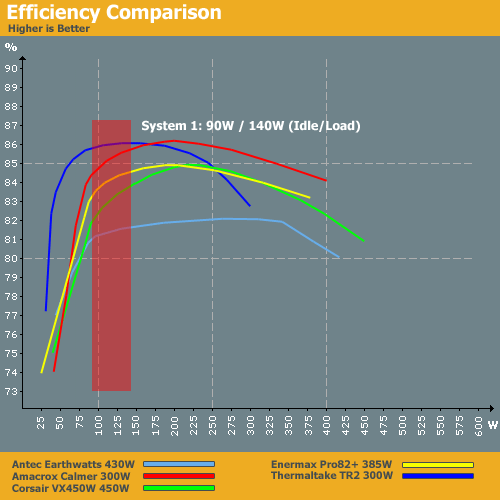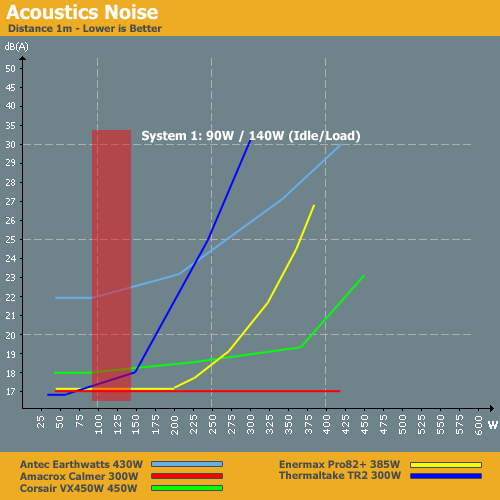Debunking Power Supply Myths
by Christoph Katzer on September 22, 2008 3:00 AM EST- Posted in
- Cases/Cooling/PSUs
Making Compromises
What we have learned from the preceding PSU example? A higher rated power supply will run much quieter if it runs at less than 50% of its rated output, but you don't want the rating to be too high or else efficiency will drop. Now we come to the more complicated part of choosing the right power supply for a new system. You need to make compromises between achieving optimal efficiency and maintaining a quiet working environment. If that is your goal, our high-end sample system is a perfect candidate for a 900W power supply like the Cooler Master UCP 900W. Efficiency is very good throughout the operating range and noise levels will be far lower than the ambient noise from the rest of the system. What we want to do now is go through the three sample systems and select an appropriate power supply.
Our entry-level system has very low power consumption, and unfortunately most power supply manufacturers completely ignore this market segment. Our goal today is to focus on quality power supplies that are readily available worldwide, and most manufacturers start with 500W models and go up from there. That limits our choices, but there are still a few options.
We can only be sure about efficiency if we've tested a power supply, so we will confine ourselves to such units. (Note that we have not necessarily published reviews on all of these power supplies, but we have tested them.) Our entry-level system uses an ATI Radeon HD 3650 graphics card, which means we don't need a PEG connector; that makes our choices a little easier. We'll focus on the following offerings:
- Thermaltake TR2 QFan (300W) actively cooled
- Enermax Pro82+ (385W) actively cooled
- Amacrox Calmer 560 (300W) passively cooled
- Corsair VX450W (450W) actively cooled
- Antec Earthwatts (430W) actively cooled

In the range of 90W to 140W, it's little surprise that the best efficiency is achieved by the two power supplies with the lowest rating (300W). The Thermaltake TR2 QFan places first in our results, and second place goes to the Amacrox Calmer 560. The Enermax takes third place, Corsair is in fourth, and Antec ranks at the bottom of these five options. If it were possible to find a 250W power supply with similar performance at a lower price, that would be even better, but it's just not possible these days. That takes care of efficiency, but let's look at noise levels.

In the same range of 90W to 140W, the Amacrox Calmer 560 and Enermax Pro82+ are the best performers, with the overall crown going to Amacrox, since the Calmer 560 is passively cooled. The Thermaltake TR2 QFan and Corsair VS450W aren't too far behind, at only 18 dB(A) max, while Antec brings up the rear again.
Looking at the above two charts, the Thermaltake TR2 QFan is a perfect candidate for our entry-level system. However, if you instead prefer silence, we would go ahead and pick up the Amacrox Calmer 560. The HD 3650 is also available with passive cooling, so you will never have to complain about computer noise. In fact, I have that exact setup and use it daily as my system for web surfing and writing articles.
As the graphs show, there's still plenty of performance available, so we could even make a few system upgrades down the road. In truth, we could run this sort of system with a 200W power supply, but there are no quality PSUs available in that range. The desire for quality is what led us to select the Amacrox, Thermaltake, Enermax, Corsair, and Antec offerings, as they all provide excellent voltage regulation and overall quality.










98 Comments
View All Comments
kuraegomon - Monday, September 22, 2008 - link
Aargh. The most important argument for ensuring that your PS has plenty of headroom is ... lifespan!The most knowledgeable PS people out there will all tell you the same thing: running even a quality PS at consistently more than 80% or so of its rated output is all but guaranteed to reduce its operational lifespan. It's also a catch-22 because the longer a PS is run at high load, the less the maximum load it can support becomes. This isn't a terribly quick process, but quite a sure one. Track down any number of JonnyGuru's comments/reviews out there for more info.
Do all the math stated in this article, and figure out what your idle and load draws approximate too, then make sure you've got 30% headroom on top of your load requirement. This is BEFORE taking into account any expansion plans. Also, try to remember that 850 PCP&C supply described here STILL isn't being used the way a power user uses their system. It's spending more time at or near peak load, but it's also quite likely spending a fair bit of time on the shelf.
7Enigma - Monday, September 22, 2008 - link
What is your point? In the article the PSU's for each category are well under 80% utilization. If you look back at the charts, in the rated range for each system:-low end is utilized <50% of rated wattage
-mid-range is utilized <75% of rated wattage
-high-end is utilized <80% except for the Neopower Blue (which honestly looks pretty crappy both from a efficiency and sound standpoint)
That is across the board. In each category the higher-rated parts are obviously utilized less than those percentages.
Even the comments below each chart bares this out. For the low end, for example, they state that a 250w PSU would be perfect, while even a 200w would suffice. With a total system draw of 140w, the 250w would be near 50% utilization (56% if you want to be picky), and the 200w would still be <75% utilization.
I don't see fault in this article from that standpoint.
vlado08 - Monday, September 22, 2008 - link
The problem is that even if you calculate the expected power draw of your system you have to trust the label on the power supply and to be sure that if it says 500w then it is so. Well then you just end up to trust the trade mark or some reviews for the model you are going to by.Or you trust somebody who is going to assemble your new computer for you.
7Enigma - Monday, September 22, 2008 - link
Thank you very much for this article. As someone building a system by the new year I appreciate it greatly!One interesting thing is that there are times where the higher wattage supplies actually make more sense due to efficiency (and probably more connectors/warranty/etc.).
The Enermax Pro82+ 625w is definitely the best mid-range you have listed IMO for a stock system (ie non-OC'd), but for someone looking to OC their system I think the Zalman850 from the high-end section is probably the better buy (both efficiency and soundwise). There is a crossover point very close to idle power levels (if you take into account another 25-50w for an OC'd system), and so anything above idle will have better efficiency and at load quieter levels.
But I haven't checked the price difference, which I'm assuming is quite large. A 1-2% efficiency difference between the Enermax and Zalman is probably not worth the increase in price from both a ROI (from power savings and increased case temp from inefficiency).
Thanks again for the great review!
vlado08 - Monday, September 22, 2008 - link
In the article you didn't mention how did you measure the power draw of different components for example the CPU or the draw from PCI express? And haw did you test the efficiency of the different power supplies?Don Tonino - Monday, September 22, 2008 - link
I found the remarks concerning the efficiency charts a bit misleading... why give the range of efficiency of the high end system, for example, as between 85% and 89%, when the first number refers to the efficiency with 90VAC? the numbers given out are not consistent, as the systems at 230VAC show in reality the following efficiencies approx:low end - 74 to 80 %
midrange - 82 to 88 %
high end - 87.5 to 89.5%
Based on the numbers above, the PSU is actually quite well suited to the high system as the efficiency changes by a meager 2% between idle and load. It would be even better with some extra load, so to place the idle/load range between 450 and 700 W.
As far as the point to make is to show how efficiency changes with the load, it would have been as meaningful to give data just for the 230VAC, as it was already stated that efficiency with 120VAC or 90VAC would be even lower.
Insomniac - Monday, September 22, 2008 - link
The range isn't for 90VAC to 240VAC, it's to cover the idle load to full load range of the sample system.Don Tonino - Monday, September 22, 2008 - link
Check the chart. For every system the lower efficiency, the one given for the sistem at idle, has a value that at that particular power load (respectively given as 90W, 168W and 310W) lies on the red line, the one representing efficiency of the PSU when running at 90VAC.This is most evident if you take the high end system, which is stated will make the PSU run at an efficiency between 85% and 89%; those values, if you move on the blu line (PSU running at 230VAC) means a power load between 200W and 650W).
Giving the idle efficiency with the PSU running at 90VAC and the load efficiency with the PSU running at 230VAC gives a much higher change in efficiency than real. The only real meaning for it would be to say: "with such a system and such a PSU you will have an efficiency between A% and B%, based on the current the PSU is running on"... and I seriously doubt that anyone at home have an electrical system that changes VAC on the run.
Insomniac - Monday, September 22, 2008 - link
I see what you are saying now. I misunderstood what you said before. It seems a table would be better to show the efficiency range for each, or the values for one curve only (the article seems to say it was supposed to only be 230 VAC).JarredWalton - Monday, September 22, 2008 - link
Sorry for the error - not sure how we missed that, but yes the efficiency with the high-end system and UCP 900W is higher than stated initially. Must have been confused with the other systems, but I'll correct the text now.